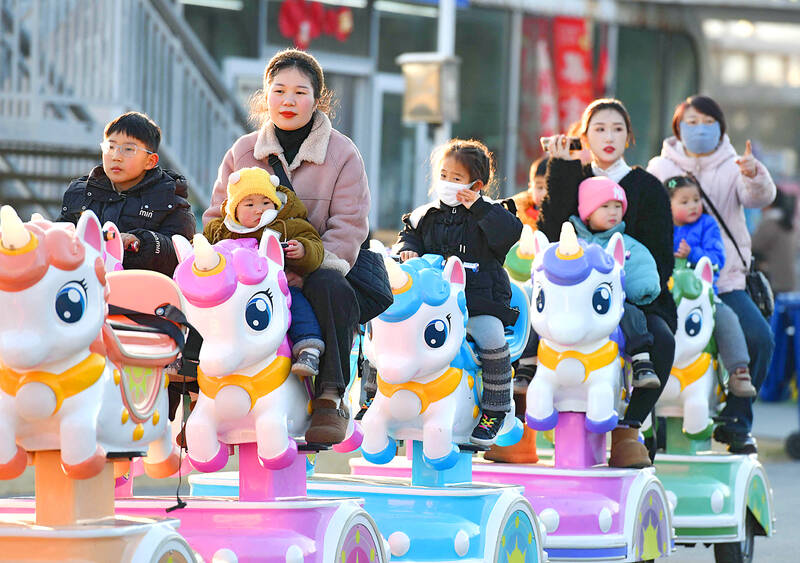DOWNTREND:
The total number of people dropped by 1.39 million to 1.408 billion. Experts warned of further declines putting pressure on the economy
China’s population fell for a third consecutive year last year, with the number of deaths outpacing a slight increase in births, and experts cautioning that the trend would accelerate in the coming years.
The Chinese National Bureau of Statistics said the total number of people in the nation dropped by 1.39 million to 1.408 billion last year, compared with 1.409 billion in 2023.
The data released yesterday reinforced concerns that the world’s second-largest economy would struggle as the number of workers and consumers declines.

Photo: AFP
Rising costs from elderly care and retirement benefits are also likely to create additional strains for already indebted local governments.
The total number of births last year was 9.54 million versus 9.02 million in 2023, the bureau said.
The birthrate rose to 6.77 births per 1,000 people last year versus 6.39 per 1,000 people in 2023.
The number of deaths was 10.93 million last year from 11.1 million in 2023.
China’s birthrate has been falling for decades as a result of the one-child policy Beijing implemented from 1980 to 2015 as well as rapid urbanization.
As in Japan and South Korea, large numbers of Chinese have moved from rural farms to cities, where having children is more expensive.
The high cost of childcare and education, job uncertainty and a slowing economy have also discouraged many young Chinese from getting married and starting a family.
Gender discrimination and traditional expectations for women to take care of the home exacerbate the issue, demographers say.
“Much of China’s population decline is rooted in entrenched structural reasons: Without fundamental structural transformations — from enhancing the social safety net to eliminating gender discrimination — the trend of population decline cannot be reversed,” said Yun Zhou, an assistant professor of sociology at the University of Michigan.
A 12.4 percent rise in marriages in 2023 — many delayed due to the COVID-19 pandemic — accounted for the rebound in births last year, but the number is expected to fall again this year, demographers said.
Marriages are a leading indicator for the birthrate in China, where many single women cannot access child-raising benefits.
Authorities last year introduced a series of measures to boost the nation’s birth rate.
Last month, they urged colleges and universities to integrate marriage and “love education” into their curriculums to emphasize positive views on marriage, love, fertility and family.
In November, China’s State Council rallied local governments to direct resources towards fixing the nation’s population crisis and spread respect for childbearing and marriages “at the right age.”
The number of Chinese women of reproductive age, defined by the UN as 15 to 49, is set to drop by more than two-thirds to under 100 million by the end of the century.
Meanwhile, the retirement-age population — those aged 60 and over — is expected to increase to more than 400 million by 2035 from about 280 million people now.
The state-run Chinese Academy of Sciences has said the pension system would run out of funds by 2035.
About 22 percent of China’s population, or 310.31 million people, were aged 60 or over last year, against 296.97 million in 2023, the data showed.
Urbanization also gathered pace with the number of people living in cities up by 10.83 million to 943.3 million. The rural population declined to 464.78 million.
#Chinas #population #falls #straight #year












Leave a Reply